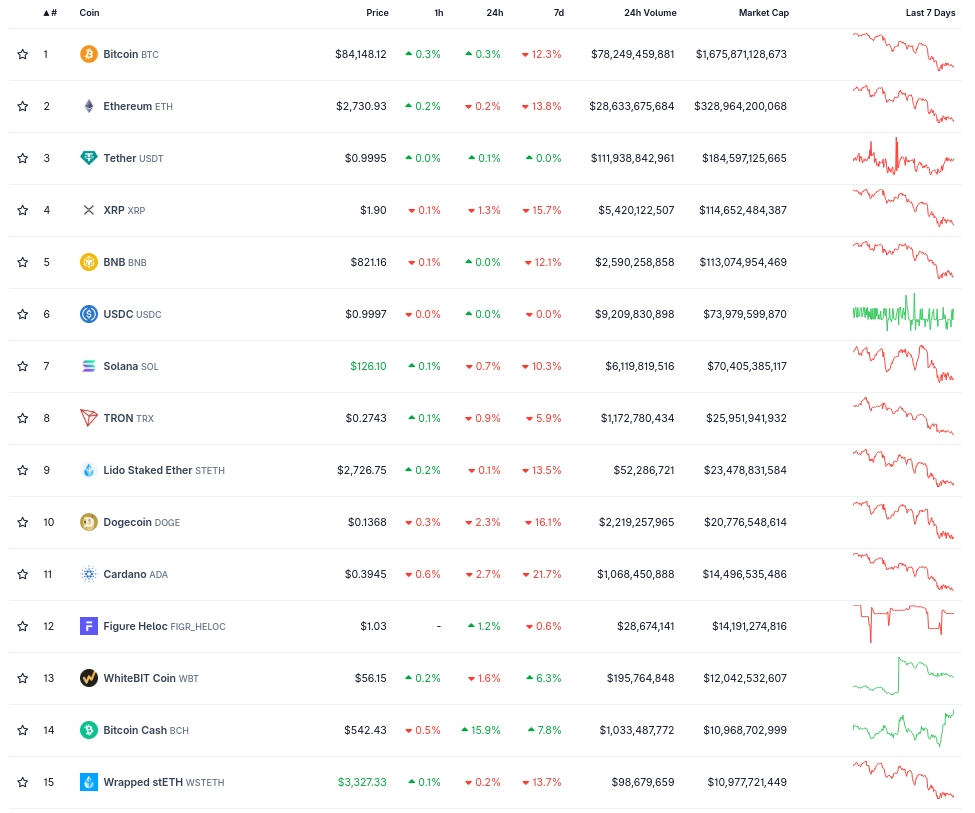
The crypto market is facing a severe correction: Bitcoin has lost nearly 30% since October, and altcoins have suffered declines of up to 90% from their all-time highs.
Cryptocurrencies are going through a correction phase marked by the sustained drop in Bitcoin's price since mid-October. After reaching an all-time high of over $126.000, The leading cryptocurrency has fallen by around 30%, settling at around $83.000Selling pressure intensified after the record-breaking liquidation event on October 10, when leveraged positions worth more than $19.000 billion were closed in just 24 hours.
The most recent drop saw Bitcoin briefly trade below $82.000, a level not seen since April. In recent weeks, the cryptocurrency's cumulative decline has hovered around 25% since the beginning of November. erasing a large part of the profits obtained during the yearThe derivatives market reflects expectations of increased volatility, as traders on platforms like Deribit prepare for further declines, suggesting that the downward pressure could continue.

Source: Coingecko
With the prolonged correction in the price of Bitcoin, The total crypto market capitalization has decreased to $2,92 trillionBitcoin's value fell 33% from its peak of $4,38 trillion in early October. According to Bloomberg, this monthly drop is the steepest since the 2022 crash, reinforcing the perception that the market is facing a deeper correction cycle.
Altcoins are caught in the storm following Bitcoin's crash
Bitcoin's pullback has hit altcoins harder, with much steeper losses. Ethereum, the second-largest cryptocurrency by market capitalization, has corrected by 40% from its all-time high, as has XRP. Meanwhile, Solana and Tron have seen declines of between 45% and 60%, while tokens like Dogecoin and Cardano have lost up to 87% from their peaks.
This drop in altcoins reflects a recurring pattern in the crypto ecosystem: when Bitcoin initiates a correction, the rest of the market tends to amplify the movement. The lack of liquidity and high speculative exposure in these assets makes them the most vulnerable. In the last week, ETH fell below $2.740, while XRP, BNB, and Solana retreated between 10% and 15%. Dogecoin, largely driven by community narratives and memes, lost more than 16% this week.

Source: Coingecko
Amid the ups and downs of the crypto market, it's not just tokens that are feeling the pressure of recent price fluctuations. Companies that rely heavily on their digital assets are also feeling the impact. Strategy, formerly known as MicroStrategy, which has amassed an impressive amount of more than 649.000 bitcoins, Bitcoin's stock value has fallen by 41% over the past month. Although Michael Saylor remains steadfast in his long-term vision and conviction regarding Bitcoin's potential, the market reality is more complex.
Although Strategy's BTC investments still reflect unrealized gains compared to the original purchase prices, some JPMorgan analysts have issued a warning that cannot be ignored. According to them, Strategy could face exclusion from key stock market indices, a situation that would not only increase pressure on the value of its bitcoin holdings but could also trigger a domino effect negatively impacting the overall crypto market, generating greater uncertainty and volatility.
Create your Bit2Me account and trade crypto.Cryptocurrencies and macroeconomics: The new heartbeat of Bitcoin and altcoins
The current correction cannot be understood solely as an internal cycle of the crypto market. Experts point out that Bitcoin and altcoins are showing an increasingly close connection with global macroeconomic trendsThe announcement of additional tariffs by President Donald Trump in October, although later revoked, triggered a wave of sell-offs that exposed the market's fragility in the face of external political and economic decisions.
Restrictive monetary policy from central banks has reduced global liquidity, limiting the ability of risk assets to sustain parabolic movements. Bitcoin's behavior seems respond more to macroeconomic signals that to internal factors such as the halving, traditionally considered a catalyst for bull markets. The slowdown in economic growth and the expectation of new restrictive measures reinforce volatility, according to experts, and cast doubt on the resilience of the crypto market in the short term.
The market capitalization and prices of major tokens reflect this growing dependence on international financial cycles. The narrative of Bitcoin as an uncorrelated asset is losing ground in the face of evidence that its behavior is increasingly tied to liquidity dynamics and monetary policy decisions.
Create your account and access BTC, ETH and altcoinsNovember in red: the crypto-ecosystem under the corrective microscope
The November crash has made it clear that the most severe impact is concentrated in the speculative areas of the ecosystem. Tokens with lower market capitalization and those driven by community narratives have suffered losses exceeding 80%, as the data shows.
This price correction has also sparked a profound debate about the future role of Bitcoin and altcoins in the market. While Bitcoin continues to solidify its position as a benchmark asset and store of value, and altcoins are experiencing growing importance—both in financial environments as strategic and diversification assets, and in technological sectors as key infrastructure for the development and innovation of Web3—both still exhibit vulnerability to external factors.
Experts point out that the growing influence of these external factors, such as central bank policies and global trade tensions, is leading the crypto market to abandon its traditional cycles and become more closely integrated with global financial dynamics.

Cryptocurrency Technical Analysis Course
Medium levelIn this training we have Iván González, a professional expert in investments and cryptocurrencies, to teach you how the market works and how prices affect the behavior of investors.


